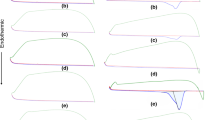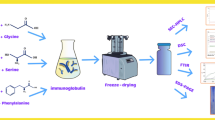Abstract
The physical state, melting behaviour and release rate of aminophylline suppositories were studied during storage. The fraction of non-crystallized fat, assessed by pulse NMR, varies between different vehicles. At room temperature several vehicles do not seem to be completely crystalline. Aging, as observed in prolonged melting time and a reduced release rate, is not expressed in a drastic reduction of the fraction of non-crystallized fat, as observed by NMR. On the contrary the mobility of the protons in the non-crystallized state is likely to offer a more promising tool to monitor aging.
Similar content being viewed by others
References
De Blaey CJ, Polderman J. Rationales in the design of rectal and vaginal delivery forms of drugs. In: Ariëns EJ, ed. Drug Design, vol. IX. London-New York: Academic Press, 1980:237.
Brower JF, Juenge EC, Page DP, Dow ML. Decomposition of aminophylline in suppository formulations. J Pharm Sci 1980;69:942–5.
Official and Tentative methods of the American Oil Chemists Society, 3rd ed. Champaign: AOCS, 1973.
Van Putte KPAM, Van den Enden J. Pulse NMR as a quick method for the determination of the solid fat content in partially crystallized fats. J Phys E Sci Instr 1973;6:910–2.
Van Putte KPAM, Van den Enden J. Fully automated determination of solid fat content by pulsed NMR. J Am Oil Chemists' Soc 1974;51:316–20.
Van Boekel MAJS. Estimation of Solid-liquid Ratios in Bulk Fats and emulsions by Pulsed Nuclear Magnetic Resonance. J Am Oil Chemists' Soc 1981, 58:767–72.
Mills BL, Van de Voort FR. Comparison of the direct and indirect wide-line nuclear magnetic resonance methods for determining solid fat content. J Am Oil Chemists' Soc 1981;58:776–8.
Farrar TC, Becker ED. Pulse and Fourier transform NMR. London-New York: Academic Press, 1971.
De Blaey CJ, Rutten-Kingma JJ. Biopharmaceutics of aminophylline suppositories I. Introduction andin vitro melting behaviour. Pharm Acta Helv 1976;51:186–92.
De Blaey CJ, Rutten-Kingma JJ. Biopharmaceutics of aminophylline suppositories. II.In vitro release rate during storage. Pharm Acta Helv 1977;52:11–4.
Lyerla JR. High resoltion nuclear magnetic resonance spectroscopy. In: Rava RR, ed. Polymers. (Marton L, Marton C, eds. Methods of Experimental Physics. Vol. 16.) London-New York: Academic Press, 1980.
Andrew ER. Molecular motions in certain solid hydrocarbons. J Chem Phys 1950;18:607–18.
Author information
Authors and Affiliations
Rights and permissions
About this article
Cite this article
De Blaey, C.J., Varkevisser, F.A. & Kalk, A. Pulsed proton NMR and solid-liquid fat ratio determinations in suppository vehicles and aminophylline suppositories. Pharmaceutisch Weekblad Scientific Edition 6, 203–208 (1984). https://doi.org/10.1007/BF01999943
Received:
Accepted:
Issue Date:
DOI: https://doi.org/10.1007/BF01999943




